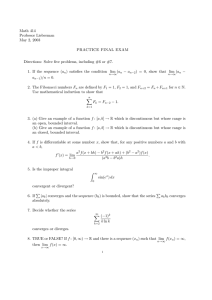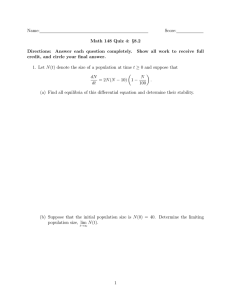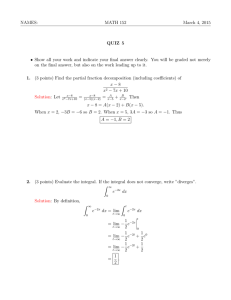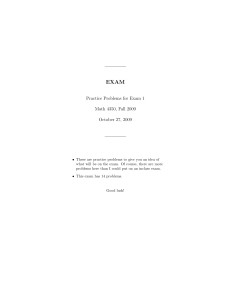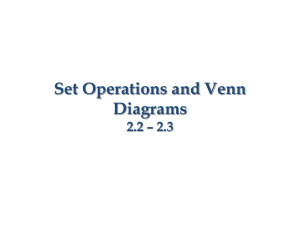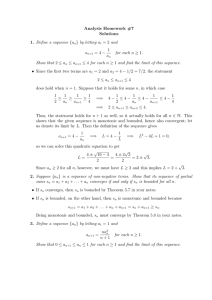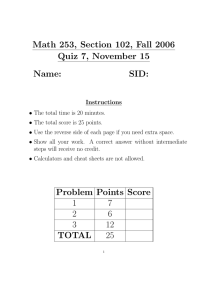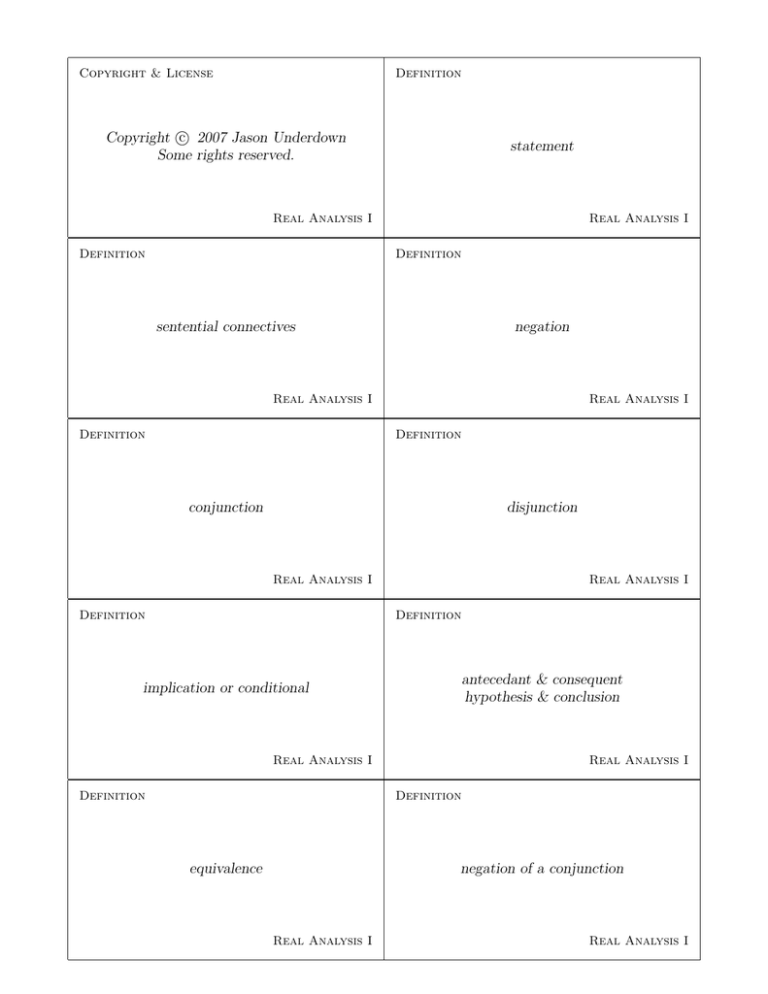
Definition
Copyright & License
c 2007 Jason Underdown
Copyright Some rights reserved.
statement
Real Analysis I
Definition
Real Analysis I
Definition
sentential connectives
negation
Real Analysis I
Definition
Real Analysis I
Definition
conjunction
disjunction
Real Analysis I
Definition
Real Analysis I
Definition
antecedant & consequent
hypothesis & conclusion
implication or conditional
Real Analysis I
Definition
Real Analysis I
Definition
equivalence
negation of a conjunction
Real Analysis I
Real Analysis I
A sentence that can unambiguously be classified as
true or false.
These flashcards and the accompanying LATEX source
code are licensed under a Creative Commons
Attribution–NonCommercial–ShareAlike 3.0 License.
For more information, see creativecommons.org. You
can contact the author at:
jasonu at physics utah edu
File last updated on Thursday 2nd August, 2007,
at 02:18
Let p stand for a statement, then ∼ p (read not p)
represents the logical opposite or negation of p.
not, and, or, if . . . then, if and only if
If p and q are statements, then the statement p or q
(called the disjunction of p and q and denoted p ∨ q)
is true unless both p and q are false.
If p and q are statements, then the statement p and
q (called the conjunction of p and q and denoted
p ∧ q) is true only when both p and q are true, and
false otherwise.
p
T
T
F
F
q
T
F
T
F
p∨q
T
T
T
F
p
T
T
F
F
q
T
F
T
F
p∧q
T
F
F
F
A statement of the form
if p then q
If p, then q.
is called an implication or conditional.
In the above, the statement p is called the antecedant
or hypothesis, and the statement q is called the
consequent or conclusion.
p
T
T
F
F
∼ (p ∧ q) ⇔ (∼ p) ∨ (∼ q)
q
T
F
T
F
p⇒q
T
F
T
T
A statement of the form “p if and only if q” is the conjunction of two implications and is called an equivalence.
Definition
Definition
negation of a disjunction
negation of an implication
Real Analysis I
Definition
Real Analysis I
Definition
tautology
universal quantifier
Real Analysis I
Definition
Real Analysis I
Definition
existential quantifier
contrapositive
Real Analysis I
Definition
Real Analysis I
Definition
converse
inverse
Real Analysis I
Definition
Real Analysis I
Definition
contradiction
subset
Real Analysis I
Real Analysis I
∼ (p ⇒ q) ⇔ p ∧ (∼ q)
∀ x, p(x)
In the above statement, the universal quantifier denoted by ∀ is read “for all”, “for each”, or “for every”.
The implication p ⇒ q is logically equivalent with its
contrapositive:
∼ q ⇒∼ p
Given the implication p ⇒ q then its inverse is
∼ p ⇒∼ q
∼ (p ∨ q) ⇔ (∼ p) ∧ (∼ q)
A sentence whose truth table contains only T is called
a tautology. The following sentences are examples of
tautologies (c ≡ contradiction):
(p ⇔ q) ⇔
(p ⇒ q) ∧ (q ⇒ p)
(p ⇒ q) ⇔
(∼ q ⇒∼ p)
(p ⇒ q) ⇔
[(p∧ ∼ q) ⇒ c]
∃ x 3 p(x)
In the above statement, the existential quantifier
denoted by ∃ is read “there exists . . . ”, “there is at
least one . . . ”. The symbol 3 is just shorthand for
“such that”.
Given the implication p ⇒ q then its converse is
q⇒p
An implication is not logically equivalent to its inverse.
The inverse is the contrapositive of the converse.
But they are not logically equivalent.
Let A and B be sets. We say that A is a subset of B
if every element of A is an element of B. In symbols,
this is denoted
A contradiction is a statement that is always false.
Contradictions are symbolized by the letter c or by
two arrows pointing directly at each other.
A ⊆ B or B ⊇ A
⇒⇐
Definition
Definition
proper subset
set equality
Real Analysis I
Definition
Real Analysis I
Definition
union, intersection, complement, disjoint
indexed family of sets
Real Analysis I
Definition
Real Analysis I
Definition
pairwise disjoint
ordered pair
Real Analysis I
Definition
Real Analysis I
Definition
Cartesian product
relation
Real Analysis I
Definition
Real Analysis I
Definition
equivalence relation
Real Analysis I
equivalence class
Real Analysis I
Let A and B be sets. We say that A is a equal to B
if A is a subset of B and B is a subset of A.
A = B ⇔ A ⊆ B and B ⊆ A
If for each element j in a nomempty set J there corresponds a set Aj , then
A = {Aj : j ∈ J}
Let A and B be sets. A is a proper subset of B if A
is a subset of B and there exists an element in B that
is not in A.
Let A and B be sets.
A∪B
= {x : x ∈ A or x ∈ B}
A∩B
A\B
= {x : x ∈ A and x ∈ B}
= {x : x ∈ A and x 6∈ B}
is called an indexed family of sets with J as the
index set.
If A ∩ B = ∅ then A and B are said to be disjoint.
The ordered pair (a, b) is the set whose members are
{a} and {a, b}.
If A is a collection of sets, then A is called
pairwise disjoint if
(a, b) = {{a}, {a, b}}
∀ A, B ∈ A , where A 6= B then A ∩ B = ∅
Let A and B be sets. A relaton between A and B is
any subset R of A × B.
If A and B are sets,then the Cartesian product or
cross product of A and B is the set of all ordered
pairs (a, b) such that a ∈ A and b ∈ B.
aRb ⇔ (a, b) ∈ R
The equivalence class of x ∈ S with respect to an
equivalence relation R is the set
Ex = {y ∈ S : yRx}
A × B = {(a, b) : a ∈ A and b ∈ B}
A relation R on a set S is an equivalence relation if
for all x, y, z ∈ S it satisfies the following criteria:
1. xRx reflexivity
2. xRy ⇒ yRx symmetry
3. xRy and yRz ⇒ xRz transitivity
Theorem
Definition
partition
function between A and B
Real Analysis I
Definition
Real Analysis I
Definition
domain
range & codomain
Real Analysis I
Definition
Real Analysis I
Definition
surjective or onto
injective or 1–1
Real Analysis I
Definition
Real Analysis I
Definition
bijective
characteristic or indicator function
Real Analysis I
Definition
Real Analysis I
Definition
image and pre-image
Real Analysis I
composition of functions
Real Analysis I
Let A and B be sets. A function between A and B
is a nonempty relation f ⊆ A × B such that
0
[(a, b) ∈ f and (a, b ) ∈ f ] =⇒ b = b
0
A partition of a set S is a collection P of nonempty
subsets of S such that
1. Each x ∈ S belongs to some subset A ∈ P.
2. For all A, B ∈ P, if A 6= B, then A ∩ B = ∅
A member of a set P is called a piece of the partition.
Let A and B be sets, and let f ⊆ A × B be a function
between A and B. The range of f is the set of all
second elements of members of f .
Let A and B be sets, and let f ⊆ A × B be a function
between A and B. The domain of f is the set of all
first elements of members of f .
rng f = {b ∈ B : ∃ a ∈ A 3 (a, b) ∈ f }
dom f = {a ∈ A : ∃ b ∈ B 3 (a, b) ∈ f }
The set B is referred to as the codomain of f .
The function f : A → B is injective or (1–1) if:
∀ a, a0 ∈ A,
f (a) = f (a0 ) =⇒ a = a0
Let A be a nonempty set and let S ⊆ A, then the
characteristic function χS : A → {0, 1} is defined
by
0 a∈
/S
χS (a) =
1 a∈S
The function f : A → B is surjective or onto if
B = rng f . Equivalently,
∀ b ∈ B,
∃ a ∈ A 3 b = f (a)
A function f : A → B is said to be bijective if f is
both surjective and injective.
Suppose f : A → B and g : B → C, then the
composition of g with f denoted by g ◦ f : A → C is
given by
(g ◦ f )(x) = g(f (x))
Suppose f : A → B, and C ⊆ A, then the image of C
under f is
f (C) = {f (x) : x ∈ C}
In terms of ordered pairs this means
If D ⊆ B then the pre-image of D in f is
g◦f = {(a, c) ∈ A×C : ∃ b ∈ B 3 (a, b) ∈ f ∧(b, c) ∈ g}
f −1 (D) = {x ∈ A : f (x) ∈ D}
Definition
Definition
inverse function
identity function
Real Analysis I
Definition
Real Analysis I
Definition
equinumerous
finite & infinite sets
Real Analysis I
Definition
Real Analysis I
Definition
cardinal number & transfinite
denumerable
Real Analysis I
Definition
Real Analysis I
Definition
countable & uncountable
power set
Real Analysis I
Definition
Real Analysis I
Definition
continuum hypothesis
Real Analysis I
algebraic & transcendental
Real Analysis I
A function that maps a set A onto itself is called the
identity function on A, and is denoted iA .
If f : A → B is a bijection, then
f −1 ◦ f
= iA
f ◦ f −1
= iB
A set S is said to be finite if S = ∅ or if there exists
an n ∈ N and a bijection
f : {1, 2, . . . , n} → S.
Let f : A → B be bijective. The inverse function of
f is the function f −1 : B → A given by
f −1 = {(y, x) ∈ B × A : (x, y) ∈ f }
Two sets S and T are equinumerous, denoted S ∼ T ,
if there exists a bijection from S onto T .
If a set is not finite, it is said to be infinite.
A set S is said to be denumerable if there exists a
bijection
f :N→S
Let In = {1, 2, . . . , n}. The cardinal number of In
is n. Let S be a set. If S ∼ In then S has n elements.
The cardinal number of ∅ is defined to be 0.
Finally, if a cardinal number is not finite, it is said to
be transfinite.
Given any set S, the power set of S denoted by P(S)
is the collection of all possible subsets of S.
A real number is said to be algebraic if it is a root of
a polynomial with integer coefficients.
If a number is not algebraic, it is called transcendental.
If a set is finite or denumerable, then it is countable.
If a set is not countable, then it is uncountable.
Given that |N| = ℵ0 and |R| = c, we know that c > ℵ0 ,
but is there any set with cardinality say λ such that
ℵ0 < λ < c ?
The conjecture that there is no such set was
first made by Cantor and is known as the
continuum hypothesis.
Axiom
Definition
well–ordering property of N
basis for induction, induction step, induction
hypothesis
Real Analysis I
Definition
Real Analysis I
Axiom
recursion relation or recurrence relation
field axioms
Real Analysis I
Axiom
Real Analysis I
Definition
order axioms
absolute value
Real Analysis I
Theorem
Real Analysis I
Definition
triangle inequality
ordered field
Real Analysis I
Definition
Real Analysis I
Definition
irrational number
Real Analysis I
upper & lower bound
Real Analysis I
In the Principle of Mathematical Induction, part (1)
which refers to P (1) being true is known as the
basis for induction.
Part (2) where one must show that ∀ k ∈ N, P (k) ⇒
P (k + 1) is known as the induction step.
If S is a nonempty subset of N, then there exists an
element m ∈ S such that ∀ k ∈ S m ≤ k.
Finally, the assumption in part (2) that P (k) is true
is known as the induction hypothesis.
A1 Closure under addition
A2 Addition is commutative
A3 Addition is associative
A4 Additive identity is 0
A5 Unique additive inverse of x is −x
M1 Closure under multiplication
M2 Multiplication is commutative
M3 Multiplication is associative
M4 Multiplicative identity is 1
M5 If x 6= 0, then the unique multiplicative inverse is 1/x
DL ∀ x, y, z ∈ R, x(y + z) = xy + xz
If x ∈ R, then the absolute value of x, is denoted |x|
and defined to be
x x≥0
|x| =
−x x < 0
A recurrence relation is an equation that defines
a sequence recursively: each term of the sequence is
defined as a function of the preceding terms.
The Fibonacci numbers are defined using the linear
recurrence relation:
Fn
= Fn−2 + Fn−1
F1
F2
=
=
1
1
O1 ∀ x, y ∈ R exactly one of the relations
x = y, x < y, x > y holds. (trichotomy)
O2 ∀ x, y, z ∈ R, x < y and y < z ⇒ x < z.
(transitivity)
O3 ∀ x, y, z ∈ R, x < y ⇒ x + z < y + z
O4 ∀ x, y, z ∈ R, x < y and z > 0 ⇒ xz < yz.
Let x, y ∈ R then
|x + y| ≤ |x| + |y|
If S is a field and satisfies (O1–O4) of the order axioms,
then S is an ordered field.
alternatively,
|a − b| ≤ |a − c| + |c − b|
Let S be a subset of R. If there exists an m ∈ R
such that m ≥ s ∀ s ∈ S, then m is called an
upper bound of S.
Similarly, if m ≤ s ∀ s ∈ S, then m is called a
lower bound of S.
Suppose x ∈ R. If x 6=
irrational.
m
n
for some m, n ∈ Z, then x is
Definition
Definition
bounded
maximum & minimum
Real Analysis I
Definition
Real Analysis I
Definition
supremum
infimum
Real Analysis I
Axiom
Real Analysis I
Definition
Completeness Axiom
Archimedean ordered field
Real Analysis I
Definition
Real Analysis I
Definition
dense
extended real numbers
Real Analysis I
Definition
Real Analysis I
Definition
neighborhood & radius
Real Analysis I
deleted neighborhood
Real Analysis I
If m is an upper bound of S and also in S, then m is
called the maximum of S.
Similarly, if m is a lower bound of S and also in S,
then m is called the minimum of S.
A set S is said to be bounded if it is bounded above
and bounded below.
Let S be a nonempty subset of R. If S is bounded
below, then the greatest lower bound is called the
infimum, and is denoted inf S.
Let S be a nonempty subset of R. If S is bounded
above, then the least upper bound is called the
supremum, and is denoted sup S.
m = inf S ⇔
m = sup S ⇔
(a) m ≤ s, ∀ s ∈ S and
(a) m ≥ s, ∀ s ∈ S and
(b) if m0 > m, then ∃ s0 ∈ S 3 s0 < m0
(b) if m0 < m, then ∃ s0 ∈ S 3 s0 > m0
An ordered field F has the Archimedean property
if
∀x∈F ∃n∈N3x<n
For convenience, we extend the set of real numbers
with two symbols ∞ and −∞, that is R ∪ {∞, −∞}.
Then for example if a set S is not bounded above, then
we can write
sup S = ∞
Let x ∈ R and ε > 0, then a deleted neighborhood
of x is
N ∗ (x; ε) = {y ∈ R : 0 < |y − x| < ε}
Every nonempty subset S of R that is bounded above
has a least upper bound. That is, sup S exists and is
a real number.
A set S is dense in a set T if
∀ t1 , t 2 ∈ T
∃ s ∈ S 3 t1 < s < t2
Let x ∈ R and ε > 0, then a neighborhood of x is
N (x; ε) = {y ∈ R : |y − x| < ε}
The number ε is referred to as the radius of N (x; ε).
Definition
Definition
interior point
boundary point
Real Analysis I
Definition
Real Analysis I
Definition
closed and open sets
accumulation point
Real Analysis I
Definition
Real Analysis I
Definition
isolated point
closure of a set
Real Analysis I
Definition
Real Analysis I
Definition
open cover
subcover
Real Analysis I
Definition
Real Analysis I
Definition
compact set
sequence
Real Analysis I
Real Analysis I
A point x ∈ R is a boundary point of S if
∀ ε > 0,
N (x; ε) ∩ S 6= ∅ and N (x; ε) ∩ (R \ S) 6= ∅
In other words, every neighborhood of a boundary
point must intersect the set S and the complement
of S in R.
Let S ⊆ R. A point x ∈ R is an interior point of S if
there exists a neigborhood N (x; ε) such that N ⊆ S.
The set of all interior points of S is denoted int S.
The set of all boundary points of S is denoted bd S.
Suppose S ⊆ R, then a point x ∈ R is called an
accumulation point of S if
∀ ε > 0,
N ∗ (x; ε) ∩ S 6= ∅
In other words, every deleted neighborhood of x contains a point in S.
Let S ⊆ R. If bd S ⊆ S, then S is said to be closed.
If bd S ⊆ R \ S, then S is said to be open.
The set of all accumulation points of S is denoted S 0 .
Let S ⊆ R. The closure of S is defined by
cl S = S ∪ S 0
Let S ⊆ R. If x ∈ S and x 6∈ S 0 , then x is called an
isolated point of S.
In other words, the closure of a set is the set itself
unioned with its set of accumulation points.
Suppose G ⊆ F are both families of indexed sets that
cover a set S, then since G is a subset of F it is called
a subcover of S.
A sequence s is a function whose domain is N. However, instead of denoting the value of s at n by s(n),
we denote it sn . The ordered set of all values of s is
denoted (sn ).
An open cover of a set S is a family or collection of
sets whose union contains S.
S ⊆ F = {Fn : n ∈ N}
A set S is compact iff every open cover of S contains
a finite subcover of S.
Note: This is a difficult definition to use because to
show that a set is compact you must show that every
open cover contains a finite subcover.
Definition
Definition
converge & diverge
bounded sequence
Real Analysis I
Definition
Real Analysis I
Definition
diverge to −∞
diverge to +∞
Real Analysis I
Definition
Real Analysis I
Definition
nondecreasing, nonincreasing & monotone
increasing & decreasing
Real Analysis I
Definition
Real Analysis I
Definition
Cauchy sequence
subsequence
Real Analysis I
Definition
Real Analysis I
Definition
subsequential limit
Real Analysis I
lim sup & lim inf
Real Analysis I
A sequence is said to be bounded if its range
{sn : n ∈ N} is bounded. Equivalently if,
∃ M ≥ 0 such that ∀ n ∈ N, |sn | ≤ M
A sequence (sn ) is said to converge to s ∈ R, denoted
(sn ) → s if
∀ ε > 0, ∃ N such that ∀ n ∈ N,
n > N ⇒ |sn − s| < ε
If a sequence does not converge, it is said to diverge.
A sequence (sn ) is said to diverge to −∞ if
A sequence (sn ) is said to diverge to +∞ if
∀ M ∈ R, ∃ N such that
∀ M ∈ R, ∃ N such that
n > N ⇒ sn < M
n > N ⇒ sn > M
A sequence (sn ) is increasing if
sn < sn+1
∀n ∈ N
A sequence (sn ) is decreasing if
sn > sn+1
∀n ∈ N
A sequence (sn ) is nondecreasing if
sn ≤ sn+1
∀n ∈ N
A sequence (sn ) is nonincreasing if
sn ≥ sn+1
∀n ∈ N
A sequence is monotone if it is either nondecreasing
or nonincreasing.
A sequence (sn ) is said to be a Cauchy sequence if
If (sn ) is any sequence and (nk ) is any strictly increasing sequence, then the sequence (snk ) is called a
subsequence of (sn ).
∀ ε > 0,
∃ N such that
m, n > N ⇒ |sn − sm | < ε
Suppose S is the set of all subsequential limits of a
sequence (sn ). The lim sup (sn ), shorthand for the
limit superior of (sn ) is defined to be
lim sup (sn ) = sup S
The lim inf (sn ), shorthand for the limit inferior of
(sn ) is defined to be
lim inf (sn ) = inf S
A subsequential limit of a sequence (sn ) is the limit
of some subsequence of (sn ).
Definition
Definition
oscillating sequence
limit of a function
Real Analysis I
Definition
Real Analysis I
Definition
sum, product, multiple, & quotient
of functions
right–hand limit
Real Analysis I
Definition
Real Analysis I
Definition
left–hand limit
continuous function at a point
Real Analysis I
Definition
Real Analysis I
Definition
continuous on S
continuous
bounded function
Real Analysis I
Definition
Real Analysis I
Definition
uniform continuity
Real Analysis I
extension of a function
Real Analysis I
Suppose f : D → R where D ⊆ R, and suppose c is an accumulation point of D. Then the
limit of f at c is L is denoted by
lim f (x) = L
x→c
and defined by
∀ ε > 0,
If lim inf (sn ) < lim sup (sn ), then we say that the
sequence (sn ) oscillates.
∃ δ > 0 such that
|x − c| < δ ⇒ |f (x) − L| < ε
Let f : (a, b) → R, then the right–hand limit of f
at a is denoted
lim f (x) = L
Let f : D → R and g : D → R, then we define:
1. sum (f + g)(x) = f (x) + g(x)
x→a+
2. product (f g)(x) = f (x)g(x)
and defined by
a < x < a + δ ⇒ |f (x) − L| < ε
3. multiple (kf )(x) = kf (x) k ∈ R
f
f (x)
4. quotient
if g(x) 6= 0 ∀x ∈ D
=
g
g(x)
Let f : D → R where D ⊆ R, and suppose c ∈ D,
then f is continuous at c if
Let f : (a, b) → R, then the left–hand limit of f at
b is denoted
lim− f (x) = L
∀ ε > 0,
∀ ε > 0,
∃ δ > 0 such that
∃ δ > 0 such that
|x − c| < δ ⇒ |f (x) − f (c)| < ε
x→b
and defined by
∀ ε > 0,
∃ δ > 0 such that
b − δ < x < b ⇒ |f (x) − L| < ε
A function is said to be bounded if its range is
bounded. Equivalently, f : D → R is bounded if
∃ M ∈ R such that ∀ x ∈ D, |f (x)| ≤ M
Suppose f : (a, b) → R, then the extension of f is
denoted f˜ : [a, b] → R and defined by
x=a
u
f (x) a < x < b
f˜(x) =
v
x=b
where lim f (x) = u and lim f (x) = v.
x→a
x→b
Let f : D → R where D ⊆ R. If f is continuous at
each point of a subset S ⊆ D, then f is said to be
continuous on S.
If f is continuous on its entire domain D, then f is
simply said to be continuous.
A function f : D → R is uniformly continuous on
D if
∀ ε > 0, ∃ δ > 0 such that
|x − y| < δ ⇒ |f (x) − f (y)| < ε
Definition
Definition
differentiable at a point
strictly increasing function
strictly decreasing function
Real Analysis I
Definition
Real Analysis I
Definition
limit at ∞
tends to ∞
Real Analysis I
Definition
Real Analysis I
Definition
Taylor polynomials for f at x0
Taylor series
Real Analysis I
Definition
Real Analysis I
Definition
partition of an interval
refinement of a partition
upper sum
Real Analysis I
Definition
Real Analysis I
Definition
upper integral
lower integral
lower sum
Real Analysis I
Real Analysis I
A function f : D → R is said to be strictly increasing if
∀ x1 , x2 ∈ D,
Suppose f : I → R where I is an interval containing
the point c. Then f is differentiable at c if the limit
x1 < x2 ⇒ f (x1 ) < f (x2 )
A function f : D → R is said to be strictly decreasing if
∀ x1 , x2 ∈ D,
lim
x→c
f (x) − f (c)
x−c
exists and is finite. Whenever this limit exists and is
finite, we denote the derivative of f at c by
x1 < x2 ⇒ f (x1 ) > f (x2 )
f 0 (c) = lim
x→c
Suppose f : (a, ∞) → R, then we say f tends to ∞
as x → ∞ and denote it by
lim f (x) = ∞
f (x) − f (c)
x−c
Suppose f : (a, ∞) → R, then the limit at infinity
of f denoted
lim f (x) = L
x→∞
x→∞
iff
iff
∀ M ∈ R,
∀ ε > 0,
∃ N > a such that
x > N ⇒ |f (x) − L| < ε
x > N ⇒ f (x) > M
If f has derivatives of all orders in a neighborhood
of x0 , then the limit of the Taylor polynomials is an
infinite series called the Taylor series of f at x0 .
p0 (x) = f (x0 )
p1 (x) = f (x0 ) + f 0 (x0 )(x − x0 )
p2 (x) = f (x0 ) + f 0 (x0 )(x − x0 ) +
∞
X
f (n) (x0 )
(x − x0 )n
f (x) =
n!
n=0
= f (x0 ) + f 0 (x0 )(x − x0 ) +
∃ N > a such that
f 00 (x0 )
(x − x0 )2
2!
..
.
f 00 (x0 )
(x − x0 )2 + · · ·
2!
Suppose f is a bounded function on [a, b] and P =
{x0 , . . . , xn } is a partition of [a, b].
For each i ∈ {1, . . . , n} let
Mi (f ) = sup{f (x) : x ∈ [xi−1 , xi ]}.
We define the upper sum of f with respect to P to
be
n
X
U (f, P ) =
Mi ∆xi
pn (x) = f (x0 ) + f 0 (x0 )(x − x0 ) + · · · +
f (n) (x0 )
(x − x0 )n
n!
A partition of an interval [a, b] is a finite set of points
P = {x0 , x1 , x2 , . . . , xn } such that
a = x0 < x1 < . . . < xn = b
If P and P 0 are two partitions of [a, b] where P ⊂ P 0
then P 0 is called a refinement of P .
i=1
where ∆xi = xi − xi−1 .
Suppose f is a bounded function on [a, b]. We define
the upper integral of f on [a, b] to be
U (f ) = inf{U (f, P ) : P any partition of [a, b]}.
Similarly, we define the lower integral of f on [a, b]
to be
L(f ) = sup{L(f, P ) : P any partition of [a, b]}.
Suppose f is a bounded function on [a, b] and P =
{x0 , . . . , xn } is a partition of [a, b].
For each i ∈ {1, . . . , n} let
mi (f ) = inf{f (x) : x ∈ [xi−1 , xi ]}.
We define the lower sum of f with respect to P to
be
n
X
L(f, P ) =
mi ∆xi
i=1
where ∆xi = xi − xi−1 .
Definition
Definition
Riemann integrable
monotone function
Real Analysis I
Definition
Real Analysis I
Definition
proper integral
improper integral
Real Analysis I
Definition
Real Analysis I
Definition
integral convergence
integral divergence
infinite series
partial sum
Real Analysis I
Definition
Real Analysis I
Definition
convergent series
sum
divergent series
diverge to +∞
Real Analysis I
Definition
Real Analysis I
Definition
harmonic series
Real Analysis I
geometric series
Real Analysis I
A function is said to be monotone if it is either increasing or decreasing.
Let f : [a, b] → R be a bounded function. If L(f ) =
U (f ), then we say f is Riemann integrable or just
integrable. Furthermore,
Z
A function is increasing if x < y ⇒ f (x) ≤ f (y).
A function is decreasing if x < y ⇒ f (x) ≥ f (y).
b
Z
f=
a
b
f (x)dx = L(f ) = U (f )
a
is called the Riemann integral or just the integral
of f on [a, b].
An improper integral is the limit of a definite integral, as an endpoint of the interval of integration approaches either a specified real number or ∞ or −∞
or, in some cases, as both endpoints approach limits.
Let f : (a, b] → R be integrable on [c, b] ∀ c ∈ (a, b]. If
Rb
limc→a+ c f exists then
Z
b
Z
b
f = lim
a
c→a+
When a function f is bounded and the interval over
which it is integrated is bounded, then if the integral
exists it is called a proper integral.
f
c
Let (ak ) be a sequence of real numbers, then we can
create a new sequence of numbers (sn ) where each sn
in (sn ) corresponds to the sum of the first n terms
of (ak ). This new sequence of sums is called an
∞
X
an .
infinite series and is denoted by
n=0
The n-th partial sum of the series, denoted by sn is
defined to be
n
X
sn =
ak
Suppose f : (a, b] → R is integrable on [c, b] ∀ c ∈ (a, b],
Rb
futhermore let L = limc→a+ c f . If L is finite, then
Rb
the improper integral a f is said to converge to L.
If L = ∞ or L = −∞, then the improper integral is
said to diverge.
k=0
If a series does not converge then it is divergent.
If the lim sn = +∞ then the series is said to diverge
n→∞
to +∞.
If (sn ) converges to a real number say s, then we say
∞
X
that the series
an = s is convergent.
n=0
Furthermore, we call s the sum of the series.
The geometric series is given by
∞
X
The harmonic series is given by
xn = 1 + x + x2 + x3 + · · ·
n=0
The geometric series converges to
and diverges otherwise.
1
for |x| < 1,
1−x
∞
X
1
1 1 1
= 1 + + + + ···
n
2 3 4
n=1
The harmonic series diverges to +∞.
Definition
Definition
converge absolutely
converge conditionally
power series
Real Analysis I
Definition
Real Analysis I
Definition
radius of convergence
interval of convergence
Real Analysis I
Definition
Real Analysis I
Definition
converges pointwise
converges uniformly
Real Analysis I
Definition
Real Analysis I
Definition
Real Analysis I
Definition
Real Analysis I
Definition
Real Analysis I
Real Analysis I
Given a sequence (an ) of real numbers, then the series
∞
X
an xn = a0 + a1 x + a2 x2 + a3 x3 + · · ·
n=0
is called a power series. The number an is called the
nth coefficient of the series.
The interval of convergence of a power series is the
∞
X
set of all x ∈ R such that
an xn converges.
n=0
By theorem we see that (for a power series centered at
0) this set will either be {0}, R or a bounded interval
centered at 0.
Let (fn ) be a sequence of functions defined on a subset
S of R. Then (fn ) converges uniformly on S to a
function f defined on S if
∀ ε > 0,
∃ N such that ∀ x ∈ S
n > N ⇒ |fn (x) − f (x)| < ε
P
P
If
|an | converges then the series
an is said to
converge absolutely.
P
P
If
|an | diverges, then the series
P an converges, but
an is said to converge conditionally.
The radius of convergence of a power series
P
an xn is an extended real number R such that (for
a power series centered at x0 )
X
|x − x0 | < R ⇒
an xn converges.
Note that R may be 0, +∞ or any number between.
Let (fn ) be a sequence of functions defined on a subset
S of R. Then (fn ) converges pointwise on S if for
each x ∈ S the sequence of numbers (fn (x)) converges.
If (fn ) converges pointwise on S, then we define f :
S → R by
f (x) = lim fn (x)
n→∞
for each x ∈ S, and we say that (fn ) converges to f
pointwise on S.

